« September 2001 | Main | November 2001 »
October 21, 2001
Overland Australia - Update 70
Latest Report - Overland Australia
SUNDAY - OCTOBER 21, 2001
DARWIN ARRIVAL
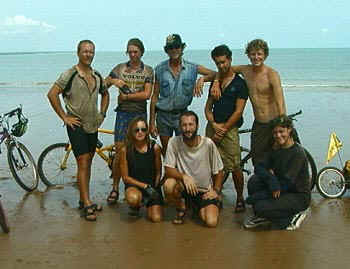
Well, we finally arrived at the shores of the Timor Sea at 09.06 a.m. on Friday morning, signifying the completion of our 88-day, 4800 km ride across Australia. There was no one there to witness our arrival save for the local news channels and a photographer from Associated Press. And why should there have been? No one in Darwin knows us from Adam.
This is new territory for the expedition - a new base from which to prepare and, in time, launch the next leg up through SE Asia (political stability permitting). It’s a few day’s breather for me before starting the local networking drive: finding a suitable venue to display the boat, booking up speaking engagements, hustling for sponsorship dollars etc etc. By now a familiar pattern that have preceded every leg of the expedition since its inception in 1992.
Our final few crank turns to the ocean were, appropriately enough, through sand. But this time there was a tangible end in sight and a just reward for our long toil from the Cape York peninsular – the cool, soothing waves of the ocean! Even the blue-green algae lapping the shoreline didn’t deter the majority of the group from riding full pelt into the drink, bicycles and all.
For those of you who have with us from our original launch point at the mouth of the Starcke River, this was a fitting way to end what was started – with our wheels in the ocean. Bottles of (cheap) champagne and VB beer were then popped and cracked accordingly and deposited in varying forms into people’s mouths and over heads and in faces etc, with suitable vulgarity. This was the team’s last chance to behave like a pack of wild animals before having to
adopt the more civilised ways required by society. And with a few weeks of
practise under our belt, we would have put the main characters of William Golding’s ‘Lord of the Flies’ to shame.
So, what now for everyone? Josh and Bel are planning on staying in Darwin to find work. Crister returns to his native California to begin a home-schooling program (centred around making damper perhaps?). John will drive the support truck back to Cairns and pick up his life again as an acoustic painter. April goes back to teaching her 5th grade class in Rye, Colorado and Mike to Salt Lake City to take a short break before possibly taking a different career choice. Todd, our long-suffering documentary cameraman, returns to San Francisco to a question mark also.
It seems a trip like this allows one a unique opportunity to step back from one’s life and see things from an objective perspective for a change, thereby allowing changes of direction/modifications to be made accordingly.
And as for the expedition and myself? Well, like I mentioned at the beginning of the update, the coffers are once again empty so finding funds to live let alone continue the expedition is the next priority. But I can’t deny to being a little tired. This leg of the expedition took a year to plan and execute, and it would be great to ‘just be’ somewhere, without having to lift a finger, rather than living in a tent
in a hot and busy campsite in the middle Darwin. But for all the wonderful aspects of a project like this, such as those we have just had the privilege of experiencing here in the Australian outback, there are always downsides. And not having a ‘home’ - as such - is one of them.
Future concerns aside, we’ve all had an incredible adventure, and we hope you’ve enjoyed sharing in them, if not a little passively, via this website.
On the ocean, each day is the same as the last. Very little changes. When we first left the Starcke River I expected the outback of Australia to be the same: hundreds upon hundreds of miles of nothingness – sand, sand and yet more sand. But the reverse couldn’t be closer to the truth. Every day has been so very different from the last, so much so that each 24 hrs has seemed like a week, a week like a month and a month a year. It feels like another lifetime ago that we left the shores of the Pacific and pushed our bright, spanking new bikes the first few unsteady yards westwards. And that has to be good thing. Time after all
has such a frightening way of slipping through fingers and disappearing
incredibly fast. But I don’t think any of us who biked into Darwin today can say that of the past 88-days.
Thanks for clicking on each day and keep coming back for a weekly update that will be posted from now on to keep you informed of how things are going. Or, if you would like to subscribe to our weekly newsletter to be automatically sent the updates, send an empty email to: x360-subscribe@egroups.com
jason
Posted at 4:17 PM
October 18, 2001
Overland Australia - Update 69
October 18, Day 87
30 kms from Darwin
Today was our last full day on the road. Starting out on an extremely twisty road, amidst tropical ferns and large wet undergrowth, we followed a railway line heading towards the Darwin River dam. We were aiming to cycle around about 50km. This would leave us approximately 20km to get us into Darwin by tomorrow morning at 9 o’clock.
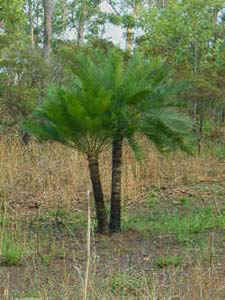
To the groups regret, we left the last of the dirt roads behind us, arriving on a small bitumen country lane and smelling the almost forgotten scent of car exhaust and road kill. The lane ever so quickly became a two lane road with the odd road train. Almost as quickly as the last change, the road turned into a four lane highway with regular road trains and the ever so consistent sound of cars travelling over 100km/h beside us; this busy road intimidated the group. While on the dirt roads a snake bite or perhaps a wild pig putting a tusk in the leg were the only fates not in our hands. The chances of either happening were quite slim but on a highway such as the one we were on, our fates were in other humans’ hands--the people who are driving the cars and trucks alongside us. We do get rather scared.
All in all though, the group is a lot happier than when we were unsure how long it would take to get us to Darwin. By 9.00 am tomorrow morning (Friday, day 88 of the Australian leg of X-360) the team will have our front wheels in the Timor Sea, signifying that we made it to Darwin.
Jim Brady, Crister’s Dad, E-mailed the group the other day. He wrote, “Darwin still ain’t going anywhere, but you guys are.”
Farewell and always remember--Feed your children wheat.
Joshua.
TO CHECK OUT THE CURRENT WEATHER CONDITIONS IN DARWIN CLICK HERE
Posted at 4:13 PM
October 17, 2001
Overland Australia - Update 68
October 17,
Day 86
A Kingfisher in route
Between Adelaide River and Batchelor
It began at the mouth of the Starcke Creek with “Ooh! A Brahminy Kite!” and continued on through the Darters and Jacanas of Lakefield National Park; the Custard-heads of the Quinkan Reserve near Maytown; the majestic Brolgas of the floodplains; the little Corellas of the grasslands; the pink Major Mitchell Cockatoos of the Centre; the dainty Fantails of the MacDonnel Ranges, the Western Bowerbird and the Quails at Trephina Gorge, the Sulphur-crested Cockatoos of the larger river systems, the Honeyeaters of Gregory Park, and the two which have hounded us incessantly for the entire trip – the vociferous and disorderly Rose-breasted Cockies (a.k.a. Galahs), and the ever-circling, hovering, waiting Fork-tail Kites (hoping they’ll get some road kill dinner out of us).

Yes, for the past eighty-six days, the team has had to listen to my relentless rhetoric on the parrots of Australia; dodge me as I cycle with my neck craned up to the treetops, swerving across the track; deal with answers like essays to the simplest bird questions (the most they hear out of me all day) and admire, again and yet again, the photograph of my pet (NOT caged) Eastern Rosella which I carry everywhere with me, and with which I regularly accost various team members. But they’ve coped terrifically - and have been brilliant at pretending they’ve never seen my photograph before; at sounding interested when, after eighty kilometres in the hot sun, I call “look look! Psittaciformes Calyptorhynchus banksii!”; and at indulging me with today’s theme.

Only occasionally, when the Trichoglossus haematodus become all too much, will Jason be prompted to tease at my Black Cockatoos: “Look - more Crows! Vermin! Get the Twenty-two!” However, I hope it’s not all for my sake, and that we’ve all learned something as we’ve marvelled at the butterfly-like flight of the Red-Winged Parrot, or the acrobatics of hunting Kingfishers. And I'm sure we’ve all had interesting experiences with hedonistic Apostle Birds and with sassy and smart-alecky Jack Russell Falcons – an impertinent Bird of Prey who has it in for our truck.
Birds have suffered from human insensitivity more than any other organism on this earth. From budgerigars in tiny cages, to battery hens being force-fed chemicals, to the poisoning of cockatoos in horticultural areas, they’ve had it all. I’ve taken the opportunity to being a bit tender and pathetic over seeing wild cockatiels and parakeets in their natural environment. After working in a pet store, listening all day to corellas repeating inanely: “What are you doing? What are you doing?”, it’s fabulous to see Budgerigars in flocks of hundreds chirruping and wheeling through the air above us, whose greatest danger is to end as road kill on the Tanami.
The most popular caged bird in the world, ‘Budgerigar’ is an Aboriginal word meaning “Good Tucker”. Australia is infinitely lucky to have such a remarkable collection of spectacular parrots. They are immediately appealing, and have enjoyed (or endured) popularity since the reports of John Gould (born 1863), a British naturalist who made the greatest contribution in history to the research and recording of Australia’s Fauna, with emphasis on birds. (See today’s history and e.s.d. updates for information on John Gould and Australia’s most beautiful bird).
Despite being just one and a half days from what used to be “our distant goal” our days continue much the same - biking along singing 1980s disco classics, with perhaps just a few more lamentable puns about Darwinists than usual. So next time I pull out a tattered picture of a handsome red and rainbow parrot, just answer, like Joshua, “Yep. Groovy.” And keep searching for the elusive Jack Russell Terrier Bird.
cheerio
bel
*Aboriginal place-names of the day:
PARRAWEENA: Parrot’s Camping Place
NURRUNGBAH: Place of the Long-nosed Shark
NUNJIKOMPITA: A Water Hole
NUTHERAMNATHERANN: A Pleasant Valley WARRAPANILLAMULLOLACOOPALLINE: A Water Hole with Cane Grass, Shaped Like a Man’s Leg with Trees Growing Round About.
We would like to thank Down Under Tours for their contribution to the expedition. Check out their web site at: www.downundertours.com
CLASSROOM ACTIVITIES >>
Science
History
Geography
Education for Sustainable Development (ESD)
Posted at 4:10 PM
October 16, 2001
Overland Australia - Update 67
October 16
Day 85
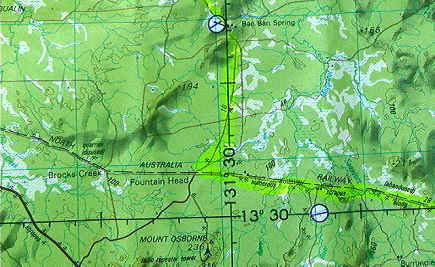
‘Decisions’
John - “Expedition 360, this is BlueDog. Anybody read?”
Jason - “BlueDog. This is Jason. Reading you loud and clear. Over”
John – “Yeah, it looks like the track running up to Mt Ringwood station is a go. A bit ‘sloppy’ from the rain they’ve had here recently according to Warren, the manager here at Ban Ban Spring, and Bill from Mt. Ringwood who I just spoke to on the phone. Slippery, but doable – a slow road though”
Jason – “BlueDog, thanks for that. Did either of the two managers give you any idea of the track? Whether it’s the quartz, sandy stuff we’ve been on, or soil?”
John - “Ah, more bull-dusty soil than sand. It’s also the flood plain for the Adelaide River, so there’s quite a bit of water lying about apparently”. A short pause, then…
Jason – “BlueDog. Sounds like a bit risky to me, especially given the clouds building as we speak. There could be some more rain this afternoon and we can’t afford getting bogged at this late stage, not that far from the highway anyway. Even though it sounds like a pretty interesting track to explore, to be fair on Mike I think we need to play safe and head for the highway.”
John – “Roger that. Also, Warren said there’s a lot of water buffalo in the area we’d be passing through. He got chased on a motorbike by one for about 4 kms the other day and he reckons they’d make short work of a push-bike rider!”
The closing stages of any leg of the expedition are always fraught with logistical dilemmas . Past ocean crossings have been especially challenging: pedalling into the island of Tarawa in July 1999 for example involved the consideration of a complex dynamic of factors such as tides, prevailing wind direction and speed, direction of currents etc, to ensure actually hitting the island rather than being swept straight past into the empty void of the west Pacific.
Making it safely through the Great Barrier Reef this time last year to finish the Coral Sea crossing with April was an even more hair-raising affair with an essential rendezvous with a support boat a few miles outside the Reef necessary to avoid the pedal boat being smashed to pieces.
Pedalling these last few days into Darwin are quite stress-free in comparison, but are not without their moments as I found out this morning in determining the best route north to Darwin. Desiring not to pedal any more kilometres on the bitumen that we absolutely have to, our plan from Pine Creek has been to pedal up the old dirt roads running parallel to the main paved Stuart Highway.
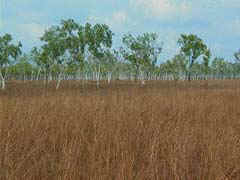
This idea has worked fine until mid-morning today when we were presented with a decision on whether to risk attempting a remote section of station tracks up through Ban Ban Spring station and Mt Ringwood station – two relatively isolated cattle properties about 75 kms east of the main highway - or to play safe and take the bitumen north.
The bottom line we have in any such decision making process is to ensure a safe arrival into Darwin this Friday morning at 09.00 hrs to allow Mike sufficient time to get airline tickets and a visa extension sorted out before the weekend.
With six other sweating, panting cyclists standing out in the rapidly increasing mid-morning heat, an early decision on such matters is always appreciated, assuming of course that it’s the right one! In the split second before recommending to John that we return to the relative safety of the highway, these were some of the factors that ran through my head: - we have approximately 200 kms to pedal in 3 days. This means a minimum of 70 kms a day – a figure we can easily do on bitumen or on a good, unsealed road. On ‘slow’ tracks, such as the one leading from Ban Ban Spring to Mt. Ringwood Station, past history suggests we do more like 40-55 kms per day, well below what we would need to make Darwin by Friday morning. -
It has rained in the past few days, and could well rain again. Bull-dust soil sounds like prime-bog material when water is added, so a good soaking could mean the truck and bikes getting bogged for a few days, even a week. Added to which the track, on closer inspection of the topographical map, runs along side the Adelaide River – not an insubstantial body of running water – which would undoubtedly increase the chances of flooding and any river crossings becoming impassable should it rain. - If we do get stuck we’d be 75 kms from the highway, not a distance we could easily get Mike to the highway across should it start raining. -
Even though attempting the route through Ban Ban Spring and Mt. Ringwood would mean a far more interested end to our 4,800 mile, 88-day pedal across the Australian outback, we (and especially Mike) would probably be worrying too much about the Friday morning deadline to really enjoy the scenery and the ride. It’s never easy to make the ‘right’ decision. Such a definition is, of course, relative to the prevailing circumstances at the time, which can change very quickly. Part of me – and the rest of the team for that matter - felt great disappointment at not being able to finish the trip as it had been planned and for the most part, executed all the way along: that of taking the lesser travelled dirt roads, station tracks and avoiding the bitumen at (almost) all costs.
But, life has an uncanny knack of never allowing one to execute a plan perfectly. Mother nature always seems to stick her oar in at some point and remind us humans, as she did so often on my previous ocean crossings, that as her guests, we are subject to the irregularities of her fickle moods whenever and wherever we least expect them.
Jason
* Aboriginal place-names of the day:
MIRRIBANDINI: A Large Kangaroo Ripped Open a Dingo which was Chasing it and Threw it Down.
TALLEBUDGERA: A Man Bitten by a Shark
PARRAGUNDI: Distant Parrots
MONACHE: A White Cockatoo with a Red Tail
WOOLARK: A Black Cockatoo with a White Tail
WIRRAGULLA: A Parrot
CLASSROOM ACTIVITIES >>
Literacy
History
Geography
Posted at 4:07 PM
October 15, 2001
Overland Australia - Update 66
October 15
Day 84
Pine Creek.
Well, here we are in ‘tropical’ Pine Creek. The mangoes on the table from a nearby tree, the quick thunderstorm that passed last night, and the constant humidity tell me that we are now ‘up-north’! We’ve got four days left till the big ‘D’ (Darwin) and my mind is mixed with thoughts of logistics when we arrive, as well as living in the moment out here where we are still very much on the trip. The last twenty-five kilometres on the bitumen of the Stuart Highway yesterday were a shock into the speedy world we know of pavement and people.

The road trains, rent-a-cars and flow of traffic overwhelmed us all as a group. Upon arriving at Pine Creek we made camp at the Lazy Lizard tourist park. After a shower and a quick wash of my bike socks, we had a logistics meeting in the open-air bar. As I sipped on my rarely-had glass of ice water we discussed the given; four days till we need to reach Darwin to meet members’ arranged flight dates.
An all unsealed (dirt) roads journey to Darwin would be the ideal. We know there is the Stuart Highway (bitumen) all the way to Darwin from where we are now. Also, we know that we would like to go to Lichfield National Park because of its rumoured beauty. Then there is the old Stuart Hwy, which winds through the landscape and also supposedly has some awesome scenery. As a group our decision-making skills have developed greatly and when all the facts were looked at, the decision was simple to make. It would take too long to go up through Lichfield, but we could take the old Stuart Highway and avoid the bitumen till literally twenty-five kilometres before Darwin.

We all agreed and the only discussions were about why the plan was a good one! As I leaned back in my chair and stood back from the group, I was able to witness how cohesive we’ve grown to be. It was pretty neat to see that. Each person’s best attributes seem to be being used as a resource to help us all out. We decided to take the morning off here in Pine Creek and just relax. The rain is gone this morning, but the clouds above make for a relatively cool breeze and I can’t wait to get back on the road at 3:00p.m. with all the people I’ve grown to respect and admire! -
Crister
*Aboriginal place-names for the day:
GUNDAGAI: To Cut the Back of the Knee with a Tomahawk
WILPENAPOUND: Bent Fingers
MILLAMURRA: Many eyes
MOOGENALLIN: A Peculiar Smell
TAENGARRAHWARRAWARILDI: The Place of the Yellow-jacket Trees
MEEE: Stars
CLASSROOM ACTIVITIES >>
Literacy
History
Environmental Studies
Posted at 4:04 PM
October 14, 2001
Overland Australia - Update 65
October 14
Day 83
Dorisvale Station
From: Todd
Everyday seems to be an adventure out here in the Outback, but some days are certainly more packed with excitement than others. Take yesterday for instance.
After our midday break to try and hide from the miserable heat we were ready to set off for our cooler evening ride. Blue Dog and April went up ahead in the truck and didn’t get more than two kilometres before being stopped by a most incredible sight. A road train full of cattle had jack-knifed sideways right at the river crossing blocking all passage across.
The tractor and both cars were on their side. The scene was just mayhem. Bullocks were everywhere and in different stages of panic—some charged past our truck and headed up the road, others darted about directionless, some had fled via water and were now looking back at the accident from across the river and downstream.
These bulls had been out in the wilds of the station for at least two years before being mustered. Now these beasts were panicked and mad. Both April and Blue Dog knew what they were dealing with and radioed back to warn us about the situation. We arrived and then, shortly thereafter, so did a tiny helicopter that landed right next to the river. Out popped two men who came to help the three stockmen and the driver who were already there. It didn’t seem long afterward that things got kind of wild.
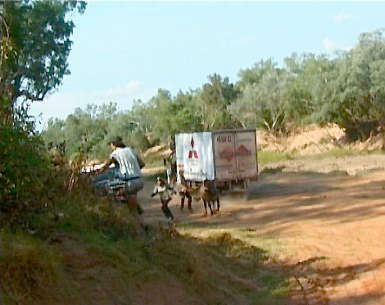
Some bulls were still inside the downed trailer and would slip-slide their way out of the compartment. The men and their dogs would be there to try and direct them up the road, safe away from the river where they could potentially drown. But these bulls were aggressive and would charge at both the men and the dogs.
The first one bolted for one of the men and began to chase him around our truck, but that’s where we were so we had to do a little running ourselves. At one point it seemed quite intent on Josh, who just barely jumped up into the cab of truck and felt the door slam closed beside him, courtesy of the bull. I was just in front of Josh, myself, and with no room left in the cab, I was left to do a dive and a roll under the truck from where I watched the rest of the melee. Bel, April and
Jason all ran up on a hillside above the action, with Jason filming the
chaos.
This happened several times over the rest of the afternoon. Most of the group took refuge at the top of the truck and watched the stockmen flee just out of reach of the bulls horns. From Jason’s view on the hill, he said we all looked like some refugees from a flood. When the action was at ebb, I came down from the truck top to get some items I had left underneath. About as soon as I got there, though, another bull came charging at the stockmen and I found myself stuck there again.
But then the truck engine turned on! Blue Dog had decided to use the truck to try and do a little mustering himself. Nobody knew that I had gone down there. Fortunately, I managed to get one of the stockmen, who was hiding by his vehicle, to motion to Blue Dog’s passenger and keep the truck from moving.
Something else that kept the truck from moving was the tipped road train. We had to camp near the scene of the accident. We were finally able to cross this morning when a large crane finally arrived and moved the trailers out of the way.
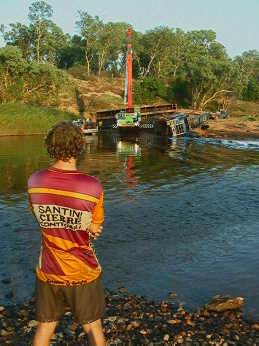
Before we left, one of the stockmen said he saw a 14-foot crocodile in the river near the accident. Unfortunately, some cattle did die and were bleeding into the river. This, apparently, attracted the one croc and is likely to attract many more to the area even after the road train has been well cleared from the scene.
In our education section, find out a little about the HISTORY of road trains in Australia, complete a MATH problem or in ENVIRONMENT find out more about those killer crocs!
Todd
*Aboriginal place-names of the day:
MUSHWANDRY: Good Place where Good People Go
GOONOONGGEREBY: A Magpie
WUDJONGMOORJUNG: Grass
SPARINDEEN: Plenty of Turtles
WINGADEE: Look at the Big Fire
WEIGHKNARLBUP: Emu Lost Feathers
WEEGOOLGURRA: A Place of Hot Weather
CLASSROOM ACTIVITIES >>
Maths
History
Environmental Studies
Posted at 4:00 PM
October 13, 2001
Overland Australia - Update 64
October 13
Day 82
Dorisvale - on the road the Pine Creek. Wild Things!
From April:
The afternoon was baking hot and confirmed by the 40C (105F) temperature registering on Crister’s wind watch. He and I had pulled up after trudging through a sandy stretch and had stopped to catch our breath, both drenched in sweat. The midday camp we had just left had afforded us relief from biking in the heat, but at 4:30 p, our world still resembled a blast furnace. And, the rocky terrain we were riding through was not conducive to any kind of cool down. The massive rock formations along the hill held the heat, then generated it back onto the landscape.
As far as we were concerned, whenever a suitable spot for evening camp was located, it couldn’t be soon enough! A few more kilometres and we got our wish. Camp was struck on a rocky outcropping overlooking a tree-filled valley, bluish in colour in the late afternoon. Cool shade from semitropical trees beckoned us from below and the possibility of a water hole seemed reasonable somewhere beneath our hill. Jason and I decided a hike in search of cool water would be in order. Dusk had fallen, but the light left to find our way over the rocks was ample.
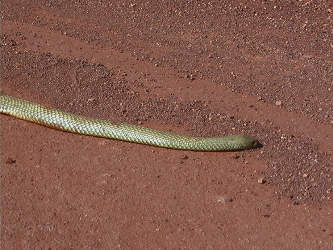
We began our descent. Jason led the way and I followed close behind. The sudden, silent movement underfoot of a King Brown caused me to yelp in alarm! Slithering from under the passing of Jason’s foot, the snake glided over the rocks and disappeared through a rocky crevice.
My ability to communicate in times of excitement becomes quite monosyllabic. (Yelp!) “WHOA! J! SNAKE! BROWN!” His reaction? “Guess I better pay a bit closer attention to where I step.” Then giving me a questioning look, “April, I’ve never heard you make a sound quite like that before,” he remarked casually. He, even keel as always, especially in the face of impending disaster, was more curious about the noise I’d raised in alarm! As my heart rate slowed, we continued our hike, but a bit more wary as to where we placed our feet.
The following morning’s ride proved equally hot and by the time we stopped for midday camp, it couldn’t have come at a better time. The campsite was heaven sent, a ford across the Flora River.
A midsize stream, it meandered through tree shaded banks, rippled over rocky breaks, creating deep pools one could stand in up to one’s neck! We dropped our bikes on the shoals and flung ourselves face down into the cool flowing water. Lacking the desire to move or splash, we lay in the shallows as the water carried the heat from our bodies. Eventually, the river begged for exploration (remember, this IS an expedition!), so Jason and I struck out, travelling upstream in ankle deep water. Clambering under fallen trees that crossed the water, through shallow pools, wading waist deep in the darker ones, we traversed the water course.
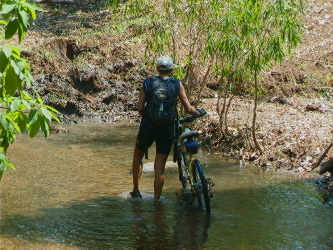
Small fish darted from under our feet as we passed. Jason led the way and I followed close behind. He had waded past a patch of murky water, a muddy, leaf-filled pocket and, as I came splashing in behind him, a sudden, gliding movement caused me to pull up suddenly.
A yelp (but more controlled than the previous evening), then, “WHOA! J! CROCODILE! TO YOU!” The five foot, fresh water croc had come out of hiding from its leafy nest, gliding to within a couple of metres of me, veered toward the bank, then disappeared. I was fairly dancing with excitement. Jason, meanwhile, stepped to the creek bank at my call, coming back downstream, hoping to find the croc’s location without scaring it away. He found it nestled among the rocks on the bottom, lying motionless. We sat down on the bank to observe him. “Wow! That’s an amazing thing to actually get the chance to see this croc! He looks a bit naughty, though,” remarked Jason.

It was an incredible thought that we are within five days of the end of the road and just now we’ve had these close encounters of the most marvellous kind. “And, what was that sound you made, April? I’ve never heard you make a sound quite like that before!” I was a bit red –faced over the fact that, for the second day in a row, I’d been startled to the point of uncontrolled yelping, completely out of character for me! What can I say? I suppose the Outback can bring out hidden traits in the best of us! The end of the story?
We’d resumed the day’s ride when I rode up on the group listening to a breathless Mike in the middle of a story. “I’m not joking! It was the biggest pig I’ve ever seen! Jason, did you see him? You had to have seen him! It ran right at me and I screamed at it! It veered away at the last minute nearly ramming my BOB trailer. C’mon, Bel, you were behind me. You SURELY had to have seen it? It’s true, it’s all true, I’m not making this up…” exasperation in his voice. “Sure, Mick, we believe you…Whatever you say…” we nodded as we pedalled off down the dusty road. Mick muttered in frustration, “But, you guys, it’s the truth. It was the biggest pig I’ve ever seen…”
April
Posted at 3:52 PM
October 11, 2001
Overland Australia - Update 63
October 11, 2001
Day 80
Mick Roney and company
‘Creepy Crawlies’
From: Mick
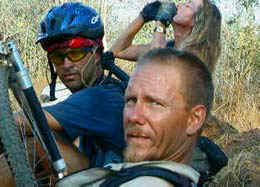
The group has unanimously agreed that I, for some larger cosmic reason, have been selected as the Vortex for any and all perils the group may encounter. A shield, if you will, that protects the rest of the group from possible harm. If danger lurks it will lurk around, over, under, or on top of me. I have for this reason become a very precious Totem for the group. They now believe, as long as I survive this trip, they will be safe. One example of this strange phenomenon happened just this morning.
I have a very fixed routine when setting up my tent at night and how I get out of it and break it down in the morning. I do this not just because I am compulsively organized and neat, but for a very smart and necessary reason to keep all the possible ‘creepy crawlers’ out of my tent. One specific part of that routine is how I take my bike shoes and socks off at night and how I put them on in the morning.
After I have set up the tent and it is time to get some sleep, I patiently look around the door of the tent to make sure there are no ‘creepy crawlers’ around. I then zip open the tent door and get in the tent, leaving my feet just outside the tent and my headlamp locked onto the area. Sweeping the headlamp back and forth to make sure of nothing coming my way, I then remove the bike shoes and place them on the ground. As for my socks, they are removed and turned inside out and placed on a hook on the outside of my tent within arm’s length, of course, so I don’t have to get out of the tent to grab them. But why turn the socks inside out you may ask?
Turning my socks inside out is a simple and effective reminder to check my shoes and socks for inhabitants before sticking my feet in them. This is a serious matter and a good habit to get into in the Outback. I had been doing just that for seventy-nine days straight. With no ‘creepy crawlers’ in the shoes and socks so far, I woke up on day eighty, which should have been my first clue, ready to go riding.
I put my headlamp on, got on my riding clothes, sat up next to the door of my tent and unzipped the flap. I immediately shined my headlamp in the dark all around the shoes and socks. The coast looked clear. I reached for my first sock. I was a bit groggy at 4:30 in the morning and did not react when my sock felt a bit heavy. However, before my brain could ‘put two and two together’, I had put the sock squarely to my face and, with the headlamp shining directly at the opening of the sock, I peeled it back with both hands. Can you say blood-curdling scream?
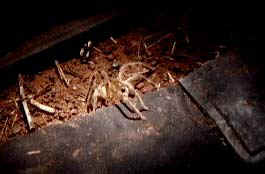
Like those pods in the movie ‘Aliens,’ my sock unleashed the biggest
barking spider I have ever seen. It hit my chin, fell on my arm and jumped with a thud on the ground just outside the tent! From the moment it was on me, it felt cold, clammy and heavy. And, yes, before I knew it, Jason and his camera were on me. At that time, the big spider and I were at a stand off, neither wanting to turn their back on the other.
As I watched the spider I began to realise it was just as scared as I. Wouldn’t you be if you were awakened by a huge giant peeling open your place of rest? Quite frankly that spider could have bitten me several times but it did not. That being said, I urged the spider on its way and enjoyed the group’s concerned remarks for me.
Those remarks were things like, “You scream like a girl” and “Afraid of a Daddy Longlegs, you big baby”. I let them have their fun and then reminded them that if it were not for me being here, one of them would have received a ‘creepy crawly’ in THEIR sock!
Mick Roney
*Aboriginal place-names for the day:
JINNERBEEKER: Bad Feet
JINNERCULURDY: Big Feet
CURRAMULKA: Emus Came Down to Drink at a Deep Water Hole, Fell In, and
were Speared by the Hunters.
MYOON MYOOAN: Red and Yellow Stones which Provide Pigment for Body
Decoration
OOLAMBULLA: Plenty of Grasshoppers
Today’s educational theme is the creepy crawlers of the Outback. You can
learn about Mike’s little friend, and the other insects whose home we
are sharing.
CLASSROOM ACTIVITIES >>
Science
Literacy
Environmental Studies

Posted at 3:46 PM
October 10, 2001
Overland Australia - Update 62
FROM THE TRAIL
October 10, 2001
From Jason:
Victoria River Roadhouse, 200kms West of Katherine on the Victoria River.
“Well, its not exactly human power, but it certainly beats the hell out of pedalling for a change. Just have to hope no one takes a photo of me to use as blackmail!”
This was the guilt-ridden thought that popped into my head (only briefly might I add) as I climbed into the saddle of a beautiful thoroughbred gelding kindly lent me to take some video footage of the herd of cattle we were following.
April, John and I had left the rest of the group at Limestone Gorge in Gregory National Park for the weekend, driving 120 kilometres to Moolooloo Station with the intention of doing some filming on the topic of ‘Cattle Ranching’ for our Discovery Zone series (a CD Rom for use predominantly in UK classrooms). We were now tailing some 500 head of ‘weaner’ calves 23 kilometres to a yard where they would be ‘drafted’ (sorted) and put out into a different paddock to the one they’d been born and raised in.
“You’re familiar with horses?” Tak – John’s old friend from Broken Hill - asked me almost apologetically as he pulled up alongside. Outback Australians seem to be that much more polite compared to their more direct and often coarser town cousins. Maybe it has something to do
with the reticence I’ve noticed people have out here. They say less and when they do it’s always with a lowered voice, as if to save any excess energy in this hot, dry climate. They also seem to give you the benefit of the doubt when first they meet you, rather than make the instant assumption that you’re an idiot.
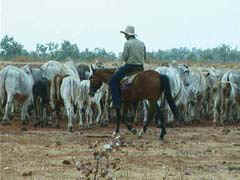
The last time I’d ridden a horse was probably before leaving the UK. But even after 7 years it all came back to me quickly – just like riding abike.
“I was brought up on a horse”, I replied without exaggeration, sinking comfortably into the deep Australian stock saddle. English saddles are like sitting on a plank of wood in comparison.
“Just making sure”, he replies with the hint of a smile curving up from the left hand side of his mouth. “Maybe the Pom’s moved up a notch,” I think to myself as the horse underneath me broke from a trot into a rolling canter. “A Pom that can ride a horse has to be better than just a Pom”.
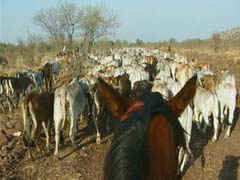
For the next 48 hours we got to sample a little of the life to be had on a Northern Territory Cattle Station; from gnawing dinosaur bones at the Saturday night BBQ to having a cardiac arrest on the toilet following the hasty exit of a large, green frog from the underside of the seat.
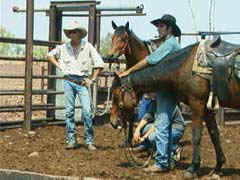
The highpoint however had to be the next afternoon when we were lucky to
experience the art of mustering cattle (gathering together) by helicopter. Dark storm clouds were already forming on the horizon as we drove the rough, 30 km track to the yard where the cattle were being mustered. Heli-mustering is a relatively recently adopted technique of gathering cattle from huge paddocks - several hundred square kilometres in size – into holding pens for necessary maintenance/sorting. The paddock in this case had the added disadvantage - at least from the perspective of being worked by horse-back – of being covered ankle deep in rocks. So mustering by helicopter often not only saves time but ultimately also money (see today’s Maths update).
After making contact on channel 1 on the truck’s UHF radio we met up with Mark Clifford, the Station Manager, who kindly allowed me to go up in one of the choppers to film from the air. After a quick 4-minute up and down – enough time at least to get the aerial shots I needed – the pilot set me down on one of the yard roofs to film the final ‘yarding up’ process of squeezing the mustered cattle the last few hundred yards through a funnel into the holding pens. At this point the heavens decided to open. Exposed on the roof as the rain gathered momentum I kept the video camera rolling for as long as I could before having to cover it with my body to avoid it being completely drenched. And this of course was the point at which the action really started.

Bear in mind these cattle are mustered only once a year, having human contact for only a few days in every 365. So for all intents and purposes they are as wild as cattle can get. All parties present were then treated in the closing stages to a truly spectacular display of acrobatics as the chopper pilot engaged in an air-to-land dogfight with a rogue mother and calf that had absolutely no interest in joining her colleagues in the pens. As the clattering machine ducked and weaved just a few feet above the ground to cut the mother from double-backing, spinning first this way then that, the mother cow likewise spun and gyrated to shake off the chopper, occasionally raising her head skyward to shake it in defiance of this airborne threat to her offspring.
Finally the mother’s efforts prevailed and she escaped behind the chopper, her calf managing to barge through the fence to freedom into a neighbouring paddock. “No worries”, said Mark as we all congregated in the pouring rain beside the pens, now filled to the brim with steaming animals. “The ringers will probably pick them up later this week during drafting”.
Half an hour later and we found ourselves labouring our way through the mud back to the homestead, our most excellent Mitsubishi 4WD Canter truck doing an amazing job of making forward progress in the black clay soil – now a muddy quagmire – where other trucks would surely fail.
After a cup of tea and some Anzac biscuits kindly given to us by Barbara- the station cook - we bid our farewells and started the long drive back to the rest of the team at Limestone Gorge.
On the way we stopped at Timber Creek to check if Git had caught her
bus to Katherine and ultimately Alice Springs, which it turned out she had.
We’d dropped her at the Wayside Inn on our way out to Moolooloo the
Friday afternoon.
Sadly she had to make the decision to drop out of the expedition for health reasons. As many of you who have been following the updates will know, Git has been wrestling with chronic back pain since leaving Alice Springs 4 weeks ago. It just made no sense for her to continue riding in the support truck.
It’s never good to lose a team member, for whatever reason. Losing Git is especially hard since she has become such an integral part of the group in such a short time. We shall miss her for our remaining time out here: her quick, dry wit, willingness to throw herself into any new challenge that might present itself, and her ability to cook thousands of perfect pancakes in 100+ degree temperatures while being attacked from all sides by squadron after squadron of voracious flies.
I only hope she found a little of what she got off the bus on the Plenty Highway to find. I remember her reply when asked why she wanted to come along (at the time she was being interviewed to join the team in the middle of the road, in the sweltering midday sun, beside a decomposing kangaroo). “The bus thing just isn’t cutting it for me” came the reply. "I need something more . . .”.
So long Git, and I think I can speak for all of us when I wish you the very best for wherever you decide to steer your life next. Like we discussed on that sandy section leading up towards Derwent Station, a few day’s before hitting the Tanami. Live your heart’s deepest desires - keep searching for that song you were born to sing.
Jason
*Aboriginal place-names for the day:
UMBERUMBERKA: A Rat Hole
YONGERLOCELKUCUP: A Plain where the Kangaroos Dance
YONGERMORANELYEIRUP: A Place where Kangaroos Scratch Holes in the
Ground
GOOTERING: A Rosella Parrot
MILBRULONG: A Rosella Parrot
JUMPINPIN: Root or Sucker of the Pandanus Tree, used for sucking
Our Educational Theme for today is 'Cattle Ranching'.
CLASSROOM ACTIVITIES >>
Maths
History
Education for Sustainable Development (ESD)
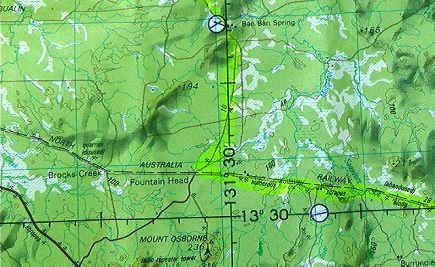
Posted at 3:40 PM
October 9, 2001
Overland Australia - Update 61
October 9, 2001
Day 78
From blue dog and John

Timber Creek
The exhaust brake made its familiar throaty rumble as Blue Dog and I entered the small (blink once and you’ve missed it) town of Timber Creek about ten kilometres ahead of the bikers. Blue peered longingly at the bar of the Wayside Inn as we passed on our way to the local Police Station.
“Could you please inform Sergeant Craig Ryan of the Alice Springs Police that Expedition 360 has made it okay to Timber Creek?” I asked the amicable Aboriginal Police Officer. “He has been monitoring our progress since we left Alice Springs four weeks ago,” I went on.
“Sure, no problem” she replied affably.
“Also, I would like to obtain permission for the Expedition to travel through Bradshaw Station. I believe it’s Australian Army property these days?”
“Yes,” she replied. “I can fax this form after you have filled it out to the Range Control in Darwin and they will fax a reply first thing tomorrow morning.”
“Thank you, I will call over about 8a.m.” I said as I went back out to the truck and Blue Dog, obviously still dreaming of the Wayside Inn.
After an unusual sleep- in this morning we had the truck packed by 8.30 a.m. The sun was shining mildly on the beautiful surrounding mountain ranges as I once again pulled the truck into the Police Station a few kilometres down Highway 1.
“They haven’t replied yet so I’ll give them a call,” said the same officer that I met yesterday. “We get quite busy here as there are only four of us to cover all of that,” indicating a huge topographical map covering one wall. “Must be over a hundred thousand square kilometres,” I thought as ‘my’ Officer was making the call for me.
“Well, they’ll get back to me in the next hour if you would like to wait back at the van park. I’ll come down there and let you know their response,” she informed me helpfully.
Jason and I turned off the highway a few kilometres further past the Police Station to check out the crossing of the Victoria River. After a few twists and turns of the dirt track, we were both stunned into silence of the view past the Crocodile Warning sign of this massive river.

“Not much wonder she said that we could only cross at low tide,” I said quietly to Jason and Blue staring at the fast flowing clear blue water obviously metres deep and several hundred metres wide.
“Yeah, and I think there would be stacks of crocs and I’ve heard that they prefer cyclists. Maybe they find cyclists’ legs good chewing,” Jason went on. Blue Dog said nothing. The satellite phone began to ring.
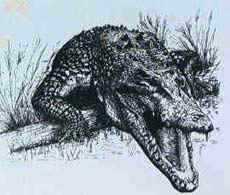
“Expedition 360” I said grabbing the phone at my right shoulder. “This is Major Neil McDade from Range Control in Darwin. I finally contacted the troops by sat-phone and they’re bogged to the eyeballs trying to get out of Bradshaw. There’s been a lot of rain over the area lately you know - so it won’t be possible for your people to get through”.
“I understand” I said, waiting for the slight delay as the phone signal made it’s way to the satellite, then to Atlanta, Georgia, back to the satellite and down to Darwin, connecting into the city phone system. “I guess we’ll travel up Highway 1 to Innesvale Station and see if we can get through to Wombungi Station that way,” I continued. “Thank you so much for your help.”
“Okay, everybody,” Jason said to the group upon our return. They were waiting patiently, lying around under the trees in the van park. “Here’s the new plan of attack . . . ”
After a cup of tea, some damper and jam, and a quick repack of the truck, Blue Dog and I headed out of Timber Creek to our designated twenty kilometre first stop and who knows what around the next bend or over the next hill . . .
John Andrews and Blue Dog.
*Aboriginal place-names of the day:
ROOLCARIRULTADUANNAARAM: One Tree on a Hill
YARRAWONGA: Where the Wonga Pigeons are found
WEEMOBAH: A Place of Permanent Fire
UMBOODEE: Big Mountain Eels in the Nearby River
COOLOONGATTA: The Highest Land
Timber Creek forms our Educational Theme for today.
CLASSROOM ACTIVITIES >>
Literacy
History
Education for Sustainable Development (ESD)
Posted at 3:34 PM
October 8, 2001
Overland Australia - Update 60
October 8, 2001
Day 77
Timber Creek
'Days off'. It must seem funny really. A bunch of people riding their bikes through Australia taking a ‘day off’ from doing so.
Yet a day off, if not two, was what we all needed. Friday the fifth we rode into Gregory National Park’s Limestone Gorge and set up camp for a two day lay over.
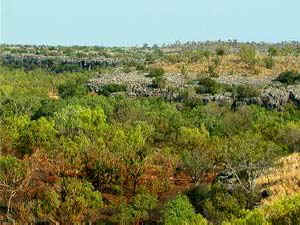
While the truck, John, Jason, April, and Git took off for some cattle mustering, Crister, Josh, Todd, Bel, and myself, hunkered down for a two nights stay at the Fly and Crock Bed and Breakfast, otherwise known as Limestone Gorge. There were indeed lots to see and do. There was no real danger being away from the truck. We had the fifty gallon water drum from the truck along with the EPIRB, (Emergency Position Indicating Radio Beacon: which you can learn more about on our i.t. educational update), so if anything was to go wrong we would be able to contact the necessary people.
We were able to swim in what was called a Billabong but what was really a dead tributary known as Limestone creek. The swimming hole was no more than 100 metres away from the croc-infested East Baines river. A river in which Limestone Creek fed during the wet. It still amazes me that while we were swimming in this beautiful, crystal clear oasis, just a few blocks down the road Saltwater crocs were feasting on the same Barramundi fish we were trying to spear.
We took in all that Limestone Gorge had to offer. Some great hikes that showed off some of the Gorge’s most sought after attractions. One hike was that of the Calcite flows - one of the main statements that represent the making of the Gorge itself. That, along with the Tufa Dams gave us quite a rich understanding of what an important and wonderful site Limestone Gorge is to Gregory National Park.
However in the fly infested, 38 C days, we found that most of our time was spent fully submerged, much like a croc, in the Limestone Gorge Billabong. Climbing up trees that hung to the waters edge and diving into the clear thirty feet deep water hole waiting for the sun to go down so that there would be no more flies to deal with, or just swimming around watching the many different varieties of fish in the Billabong.
Due to the weather and the local wild life our days off were quite regimented. To that effect, I would like to speak for the biking group that had two days off playing around in Limestone Gorge and say that “The group, though looking like a bunch of water logged prunes, had a somewhat restful time in Gregory National Park and is quite ready to get back to biking a few kilometres to Darwin.
If you would like to learn more about Limestone Gorge please go now to our educational site for more in-depth and serious write ups.
Mick
* Aboriginal place-names for the day:
WALGEEMARRBIMCARING: A Place where Crows stole the Meat and carried it Away
QUANDIALLA: A Porcupine
DENILIQUIN: The Headman of a Local Tribe who is said to have killed the First White Man he Met
GOORINGAMBONE: Hair growing out of the ears
WASHIMBERRIBIN: A Flying Squirrel
YAMADAGOOLBURRA: I Understand You
COOTAPATAMBA: Where Eagles Drink
COONKIE: Place of the Evil Spirit
CLASSROOM ACTIVITIES >>
Science
IT
Geography
Environmental Studies
Posted at 3:32 PM
October 4, 2001
Overland Australia - Update 59
October 4, 2001
Day 73
Camped on the Humbert River, Gregory National Park, Northern Territory
from Josh
Well, we fell asleep last night listening to the storms that were surrounding the Park. When I woke up the whole area looked as though it was a completely different place, even the flies weren’t as bad. Well the flies did come out, and because we started the day on the top of a ridge we had some really, really cool downhill stints.
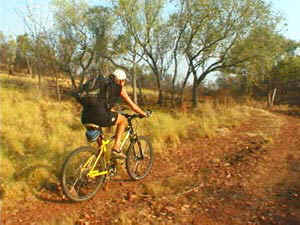
Somehow or another my rear brakes have stopped working so during the course of the day I had some rather challenging downhill runs. At one point, after we had been getting some fatty air (getting air by jumping) off rocks, slight hills etc.., I saw the most deadly spot to do a jump.
So I sped up and launched off this rock gaining about 1.5 metres in the air. When I landed, I bounced and slipped and ploughed into a poor innocent tree that decided to grow beside a really cool spot to jump. The tree was fine, I was fine and the bike was fine. All ended well.
The land around us is just simply spectacular. The group saw the first
Boab tree today (see environment update); the tree is absolutely amazing, a giant trunk and rather small branches. I attempted to catch a fish today, and failed. I also attempted and am currently attempting to kill all the flies that are bugging me at the moment, but failing.
We got word that the first flight that one of our group members has to catch is just over two weeks away, so to get there for him to catch the flight and get organised we must be in Darwin by no later than the eighteenth of this month. That gives us two weeks from today.
The flies are still bad. As a matter of fact, they are so bad that I can hardly type, ‘cause I am swatting at the rotten mongrels, only occasionally getting one. It’s driving me nuts.
We are camped down by a river bed and the creek is simply fabulous to swim in, though as we get further north we have to be rather wary about where we swim -- crocodiles can be a problem.
All in all, the day has been one I will remember because of all the beautiful land we have been travelling through.
Feed your children wheat.
Aboriginal place-names for the day:
YAREEHAPPINNI: The Head of a Native Bear Rolling Down the Hill
QUATQUATTA: Plenty of Fish
WODRABIGGUNNI: No-Good Fellow Addicted to Swearing
BAARROOK: An Island Like a Duck Resting in the Water
PEDDYBANG: An Emu
APURLA: White Mans Camp
Our educational theme for today is "Gregory National Park II."
CLASSROOM ACTIVITIES >>
Maths
History
Environmental Studies
Posted at 3:29 PM
October 2, 2001
Overland Australia - Update 58
October 2, 2001
Day 73
A Change of Routine
Gregory National Park - 80kms south of Timber Creek, Northern Territory
from April
The roar and popping of the blaze brought sleepy bike riders from their tents. In the darkness of 4 a.m., the eerie redness of the setting moon would soon give way to the rising of an equally blood red sun, masked by smoke hanging in the air.

The night before, we’d assessed the fire danger from the burning red line on the horizon, but knew our camping site wasn’t vulnerable as the surface vegetation had itself seen recent attention from a fire. Fire fuel was limited. This morning, however, the roar of flames was a bit disconcerting until the wind suddenly kicked up, carrying the fire line in the opposite direction. By the time we left, only filtered clouds of smoke remained.
We were travelling north on a public access road toward Gregory National Park. The usual corrugations, deep gravel and chunky rocks created the roadbed. But, the changing scenery of hills covered with lush grasses and an overcast sky made the ride quite enjoyable. By midmorning, our ‘quit time’ of late, found us making a group decision to continue biking into the afternoon.
Since it was cooler today, we opted to make miles until 3 pm, at which time we’d camp. This was our routine until we got farther north and things began to heat up midday. Since then, we’ve used a four hour, midday break to write updates, etc, finishing our day’s biking in the cooler hours before sunset.
Curious brahma cattle and station horse herds followed us out of curiosity as we progressed. The transition zone between the Top End and the arid centre is some of the finest pastoral country to be found. Leaving the station road behind, we turned off at the entrance to Gregory National Park.
The sign said ‘4x4 Vehicles Recommended’ and that whetted our appetites. At last, some interesting roads which would, no doubt, mirror the landscape we’d entered, up and down! Is it easy? Not by a long shot!
These roads are technically demanding, then smooth as a bitumen-like surface until they drop out of sight unexpectedly into a boulder filled creek bed. Climbing out via a vertical incline filled with sand can be a down shifting challenge to accommodate the varied terrain.
I’d run out of gears half way up the rocky slope so I stepped off and pushed my bike on toward the top of the hill. The sun had returned about an hour before and now sweat was coursing down my back, arms, and off my face. Crister and Bel pulled up beside me. “So, how hot do you guess that it is?” I panted. “Maybe 35C (95F)?” Crister dug out his wind watch and recorded 39C. How hot is that in F? Bel calculated it at 103F! No wonder I was sweating in proportion to the litres of water I had been guzzling.
The plan had been to stop by 3pm, but at that time I was still ten kilometres from camp. I was moving along at a comfortable pace with Crister, Bel and Josh somewhere behind me. Suddenly, the uneasy sensation of heat fatigue began to rear its ugly head. I pushed on, picking up my pace, wondering if at every bend in the road I would see the welcome sight of the truck parked for our evening camp.
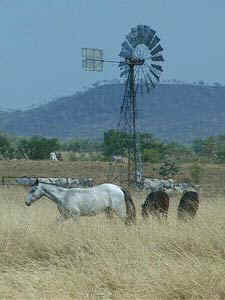
The others caught up with me and we literally dropped into camp, a beautiful shady creek bed framed by a large area of cool water. The sounds of splashing from team members who had already made it into camp, filled my ears. I dropped my bike in the shady road and sat down beside it to catch my breath. Too tired to move, I relaxed a bit, overjoyed to be out of the hot sun. A rustling beside me, then the sensation of water being poured over my head, shoulders, and back.
Dear Bel had sensed my inability to continue and had come to the rescue. A breeze cooled my water soaked skin and I was revived.
At the team meeting later that afternoon, it was decided nothing had been gained by pushing on during the heat of the day and we would gladly return to the ‘afternoon off’ schedule once again. For now, our time seems better spent ‘brushing up’ during midday like the local livestock. And, I, personally, look forward to biking toward these magnificent sunsets once again!
CLASSROOM ACTIVITIES >>
History
Geography
Education for Sustainable Development (ESD)
Posted at 3:26 PM
October 1, 2001
Overland Australia - Update 57
October 1, 2001
Day 70
Kalkaringi
from Josh
Today I felt as though we had crossed over a line, separating the southern dry country with the northern wetter country. While cycling we saw two new types of flowers and two separate bodies of water. I thought the water was the most significant out of the two; all the water we’ve have seen during the last two weeks has been from bores. These bores have been mainly for use by cattle, so we’ve been washing ourselves in cattle troughs for the last couple of washes. We had a great experience last night when we found a bore that actually worked. I filled one of the wash basins and had myself a bath under the stars -- quite enjoyable.

Right this very second I am looking at the Victoria River, along side of Kalkaringi, with flies bugging me and Mike and Git swimming and talking about crocodiles. The Victoria River is the largest mass of water that we have seen since the Mitchell River in North Queensland.

The crossing of the Victoria River to many of the group signifies crossing into the north. We are about to go into Gregory National Park, only about 60kms away.
Feed your Children Wheat.
Aboriginal place-names of the day:
JUKEMERING: Thigh Bones of Kangaroos
DHOONYGOOROONTHIE: Sunset
DHOONYWULGUNNY: Sunrise
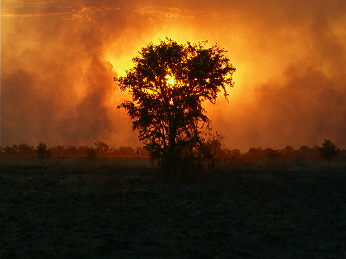
Our educational theme for today is "Victoria River District."
CLASSROOM ACTIVITIES >>
History
Geography
Environmental Studies
Posted at 2:54 PM